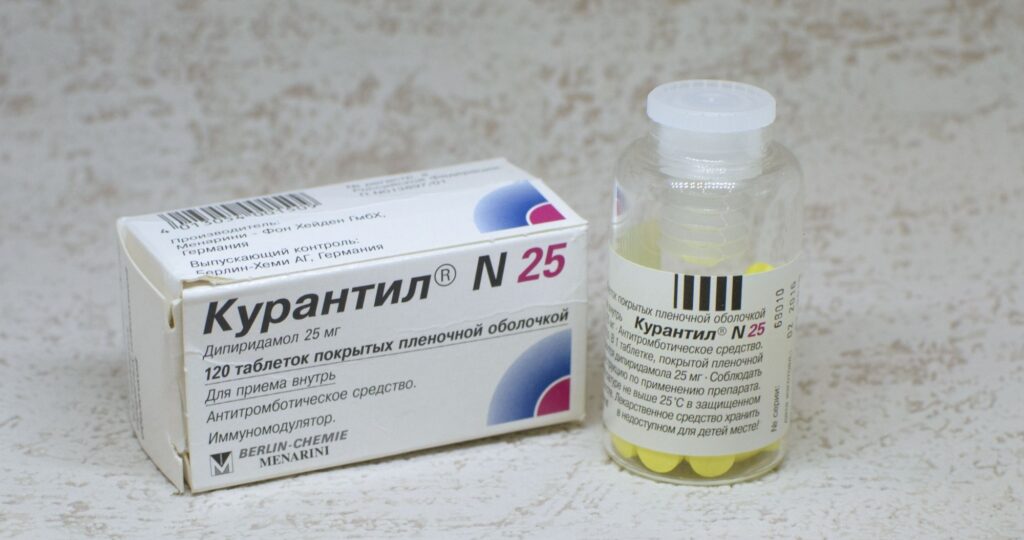With the onset of pregnancy, expectant mothers try to avoid taking any medications, at least those that are not associated with the treatment of existing chronic diseases or those that have to take for vital signs. So against the background of the seemingly benign course of pregnancy, they are very negatively to doctors’ appointments associated with the need to take “chemistry” in any form, believing that it will have for the health of the unborn child.
However, pills and pills are different, and modern obstetricians and gynecologists are also aware of the possible negative impact of certain drugs on the baby. They often prescribe Courantil to pregnant women both to prevent all sorts of complications in the fetus and mother, and for therapeutic purposes. It is worth to understand what this drug is and why Kurantil is prescribed during pregnancy.

What is it and why do they prescribe it?
Scientifically speaking, Curantil is a drug of the immunomodulator group of antiaggregants, produced by the German pharmaceutical company Berlin-Chemie. The release form-factor is dragees and tablets, which contain a different dosage of the ingredients of the drug. The action of the drug is aimed at increasing immunity and preventing the formation of blood clots. In addition, it helps to:
- normalization of venous outflow;
- reduction of cerebral vascular resistance;
- Correction of placental blood flow;
- Prevention of placental dystrophic changes, elimination of fetal tissue hypoxia at risk of preeclampsia.
The action of the drug is based on the formation of strong bonds with plasma proteins, accumulation in red blood cells – red blood cells and in the heart after oral administration. It is then eliminated from the body with bile after preliminary decomposition (metabolization) in the liver.

Shape of production
The drug is available in tablets or pills. They have a round cylindrical or circular shape, covered with a shell with a smooth homogeneous surface, the color of which is yellow to yellowish-green. In pharmacies you can see preparations with the name “Curantil 25” and “Curantil 75” with a dosage of 25 mg and 75 mg, respectively. One package of the drug in the smaller dosage contains 1 glass vial containing 120 tablets, the number of which is usually designed for a course of taking – 1-3 months.
Curantil 75 package contains 2 blisters, each containing 20 tablets. Drages can also be purchased in pharmacies in packages containing glass vials, where they are in an amount of 100 pieces, each dragee contains 25 mg of the active substance. The dosage and regimen of administration during pregnancy is prescribed by the doctor.

Indications for use
The instructions for use prescribes the prescription of tablets for pregnant women with the following diseases or health disorders:
- Varicose veins, in which there is an increased risk of edema and the formation of blood clots;
- Increased blood clotting, also with the risk of blood clots, which requires thinning of the blood;
- Pregnancy failure in a woman, such as a miscarriage;
- Coronary heart disease, to prevent blood clots in the vessels that supply the heart muscle;
- Atherosclerosis, which provokes the deposition of cholesterol on blood vessels and the formation of blood clots in this area;
- cardiovascular disease.
The doctor may prescribe to take the drug if the pregnant woman is diagnosed with placental insufficiency, impaired blood supply in the uterus, kidneys and other organs, and if pregnancy is overdone.

Contraindications
Although specialized specialists who lead pregnancy are well aware of all the contraindications to taking Curantil, it would not hurt to become familiar with them and future mothers to take them, if necessary, with a calm heart. Curantil 25 and 75 are categorically forbidden if a woman is diagnosed with, among other things:
- heart rhythm disorder;
- lactase deficiency;
- acute myocardial infarction;
- Gastric and duodenal ulcer (during exacerbation);
- Kidney and/or liver disease;
- Certain cardiac diseases;
- Chronic lung dysfunction.
Individual intolerance to the components of the drug also excludes taking Curantil in any dosage. The verdict on the necessity for pregnant women to take the drug in each case is made only by the attending physician, taking into account the general condition of the patient and the results of tests.

Instructions for use and dosage
The attitude to the use of the drug when carrying a child varies from one specialist to another. Domestic doctors usually prescribe its use in the early terms for preventive purposes and correction of conditions. Depending on the course of pregnancy and the woman’s health, the gynecologist prescribes a treatment regimen. It could last, for example, almost three trimesters until delivery, or be assigned a course.
How to take Curantil during pregnancy also advises the specialist who sees a woman. Usually in the early terms, a dosage of 25 mg is prescribed. Instructions prescribe taking the drug several times a day – an hour before a meal or 2 hours after it. The tablets should be swallowed without chewing, whole, with a small amount of water.
Reception should be made at the same time. Taking Curantil 25 or 75, you should monitor your well-being. If there are any adverse reactions – immediately consult a doctor.
Side effects
Side effects when using the drug in therapeutic doses are usually transient, expressed mildly, and are manifested during pregnancy by
- nervous system – headache, dizziness, noise in the head, impaired coordination of movements;
- the cardiovascular system – a decrease in blood pressure, heart trouble (decrease or increase the number of heartbeats), the rush of blood to the face;
- digestive organs – diarrhea, nausea, vomiting;
- blood coagulation system – bleeding, decreased number of platelets in blood, changes in their functional properties.
Side effects may appear in the form of skin rash, including urticaria, joint and muscle pain, runny nose, feeling of blocked ear. An overdose should not be allowed – it only aggravates the side effects. In this case, immediate gastric lavage and an ambulance will be required.
Interaction with other drugs
It is necessary to take the remedy, taking into account also its interaction with other drugs and other substances. For example, the instructions emphasize that simultaneous use of acetylsalicylic acid or anticoagulants with the drug leads to a significant increase in their antithrombotic properties and, as a consequence, may lead to an increased risk of hemorrhagic complications.
During the period of taking the pills it is required to limit as much as possible the consumption of black tea, coffee and products during pregnancy that contain substances similar to them. The components included in these drinks very significantly reduce or completely negate the effect of the drug. Also, simultaneous use of xanthine derivatives and Curantil pills or tablets weakens the vasodilating properties of the drug.

Analogues
In some cases, taking the drug during pregnancy is not possible and its replacement with analogues is required. For example, if a pregnant woman has allergic reactions. Full-value substitutes for the drug are the popular drugs Dipyridamol and Actovegin. They are used widely enough due to the best price-quality ratio. Making a choice in favor of Actovengin, it is worth bearing in mind that it is more aggressive, the action of the drug is too strong, its reception is a priority only if the health of the pregnant woman is in danger.
In the case of Dipyridamole, it is distinguished only by its affordability. Curantil is a foreign drug and is more expensive. Therefore, it is possible to replace it with Dipyridamole if there are financial problems. In addition, among the acceptable substitutes are drugs such as Parcedil, Agrenox, Trombonil, Persantin. However, all substitutes must be prescribed by a physician.



Download the app and get 7 days free use



